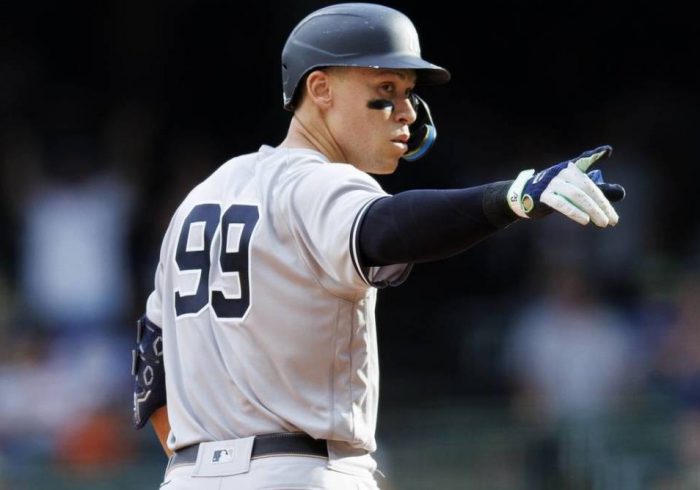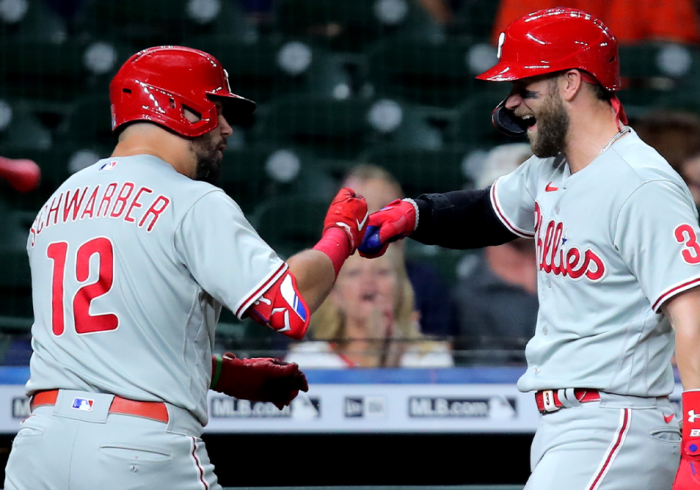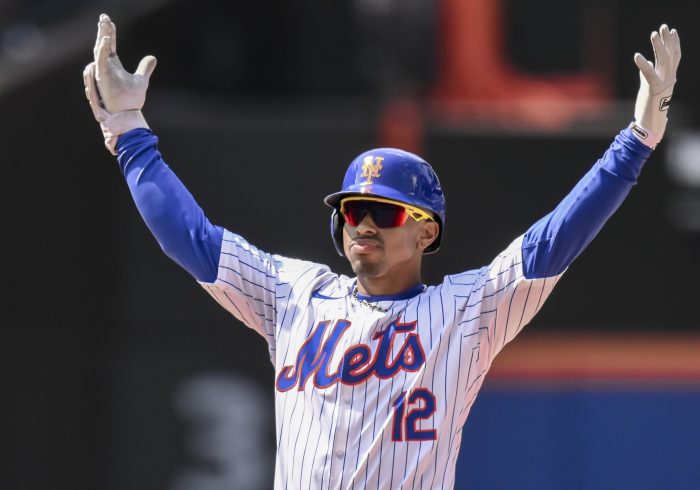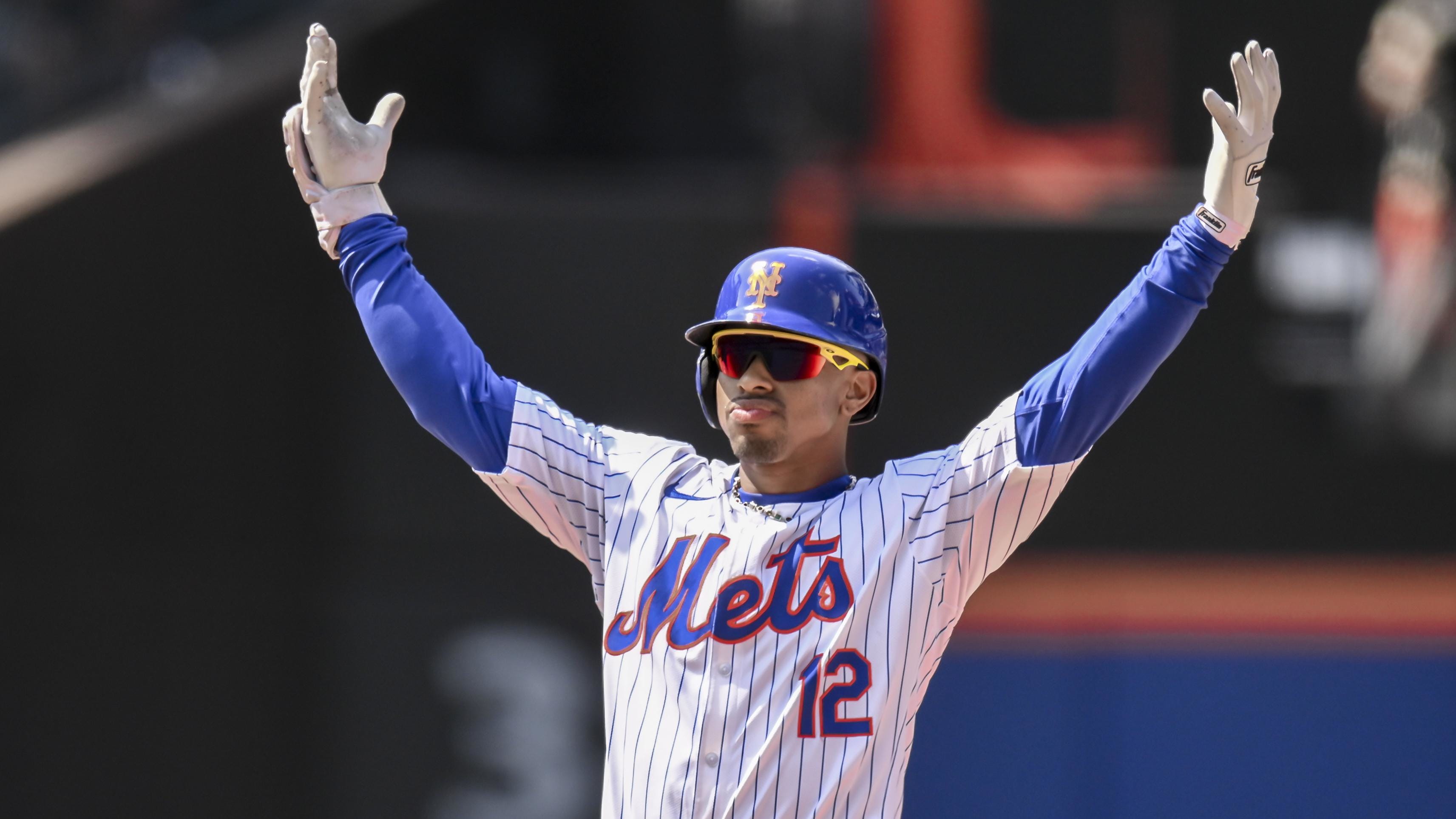Good morning, I’m Dan Gartland. The first day of the LDS really lived up to the hype.
In today’s SI:AM:
☘️ The Celtics’ pursuit of a title
⚾ Gerrit Cole rises to the occasion
Plenty to second-guess
The first eight innings of Game 1 against the Astros went about as well as the Mariners could have hoped. Seattle hitters lit up Justin Verlander, the likely AL Cy Young winner, for six runs on 10 hits in four innings. After Eugenio Suárez’s home run in the seventh, the Mariners led 7–3. Andrés Muñoz gave up a two-run homer to Alex Bregman in the bottom of the eighth, but Seattle still held a 7–5 advantage headed into the bottom of the ninth.
Everything was shaping up well for the Mariners at that point. They were about to hand the ball to their closer, Paul Sewald, who would attempt to finish off the Astros and give Seattle a monumental road victory in a short playoff series.
Sewald got Christian Vázquez to ground out, hit David Hensley with a pitch, struck out Jose Altuve and then allowed a two-out single to Jeremy Peña. That brought up Yordan Alvarez—one of the best hitters in baseball—representing the winning run.
One aspect of what manager Scott Servais did next can’t be argued with. He made the right call in pulling Sewald, who had given up four runs while recording just two outs in Game 2 against the Blue Jays. Servais’s decision for his replacement was a head-scratcher, especially in retrospect.
He went with Robbie Ray, who promptly surrendered a walk-off home run. It was the first walk-off homer by a team trailing by multiple runs in playoff history.
So why did Servais choose Ray? Let’s break down the pros and cons:
Pros
- He won the 2021 AL Cy Young.
- He’s a lefty, like Alvarez.
Cons
- He’s a starter who had made only six relief appearances in his career (including the postseason).
- Alvarez isn’t a hitter who’s affected by the platoon advantage. He batted .299/.404/.627 against righties this season and .321/.412/.586 against lefties.
- Alvarez excels against pitchers like Ray. Ray throws mostly four-seam fastballs and, by Baseball Savant’s run value metric, only Aaron Judge was better than Alvarez against four-seamers this season.
Servais still had two quality relievers available in Matthew Boyd and Erik Swanson, both of whom have WHIPs under 1.000 this season. Boyd is a lefty, if Servais really believed there was some matchup advantage there. Both guys are, crucially, actually relief pitchers and accustomed to getting warmed up quickly and entering in the middle of an inning.
Here’s how Servais explained the decision after the game:
It was something going into the series where we were at, looking at our rotation, where we were going to head, and talking with Robbie about using him out of the bullpen as a bullet, so to speak, for that type of scenario. You know, bringing in a lefty against Alvarez, although Alvarez is one of the better hitters in the league.
But we talked about it coming into the series. We talked about it pregame today. I looked at it in the seventh inning and said, hey, this could happen. So that was the plan going in.
If the move works, Servais looks brilliant. But it didn’t, and now the Mariners have to hope they can rebound from squandering a golden opportunity to seize an early advantage in the series.
The best of Sports Illustrated
Today’s Daily Cover comes from the NBA preview issue of the magazine, in which Chris Mannix checks in on the Celtics and their tumultuous offseason.
Gerrit Cole did an excellent job getting out of trouble in Game 1 against the Guardians, Stephanie Apstein writes. … Tom Verducci breaks down Dodgers manager Dave Roberts’s unusual but effective bullpen strategy. … Richard Johnson weighs the NFL draft prospects of five college football players after last weekend’s games. … The undefeated Eagles actually fell in Conor Orr’s NFL power rankings. … Here are the matchups, spreads and odds for SI Sportsbook’s Perfect 10 contest for Week 6.
Around the sports world
Merritt Paulson is stepping down as CEO of the Thorns and Timbers as the fallout from the NWSL scandal continues. … Former Angels employee Eric Kay was sentenced to 22 years in prison for his role in the death of pitcher Tyler Skaggs. … Draymond Green will not be suspended by the Warriors for punching Jordan Poole. … The photographer who was shoved by Davante Adams has filed assault charges. … Kylian Mbappé is reportedly looking to leave PSG. … Giants punter Jamie Gillan is still in London due to a passport issue.
The top five…
… biggest plays in baseball yesterday (besides Alvarez’s homer):
5. Yankees rookie Oswaldo Cabrera’s leaping catch.
4. Anthony Rizzo’s towering home run to increase the Yankees’ lead.
3. The Dodgers’ double play to get out of an inning with the Padres threatening.
2. Matt Olson’s three-run homer to bring the Braves to within one.
1. Nick Castellanos’s diving catch in the bottom of the ninth.
SIQ
How many goals did Maple Leafs star Auston Matthews score in his NHL debut on this day in 2016?
Yesterday’s SIQ: True or false: On Oct. 11, 1992, Deion Sanders played in both a regular-season game for the Falcons and a playoff game for the Braves.
Answer: False. Sanders played in the Falcons’ game that day against the Dolphins and did take flight to Pittsburgh to join the Braves for their NLCS game against the Pirates but didn’t actually get in the game.
The 1992 season was Deion’s best as a baseball player. After struggling in his first three years in the majors, Sanders was a legitimately good hitter in ’92, batting .304 with an MLB-best 14 triples. Until football season began, he was the starting center fielder for a Braves team that won 98 games and finished first in the NL West. So you can understand why the Braves would have wanted him around for the playoffs.
The stars aligned Oct. 11 for Sanders to try to play for both teams on the same day. The Falcons had a game in Miami against the Dolphins scheduled to kick off at 1 p.m., and the Braves’ NLCS Game 5 against the Pirates didn’t begin in Pittsburgh until 8:45 p.m., giving Sanders enough time to fly north and trade his football cleats for baseball spikes.
Sanders chartered a jet to take him from Pittsburgh (where he entered Game 4 as a defensive replacement in the seventh inning) to Miami and back again. Nike reportedly paid for the plane, though Sanders’s attorney has denied that. Sanders hoped he would be able to make the Braves happy while also avoiding having to forfeit his $117,000 game check from the Falcons.
Except the Braves weren’t happy. Sanders didn’t tell them until the day before that he was going to try to play in both games that Sunday. Braves general manager John Schuerholz said he wouldn’t have put Sanders on the postseason roster if he had known Sanders wanted to play football, too.
“Why would we volunteer to put ourselves in the position to play with 24 guys if somebody puts a helmet in his knee?” Schuerholz told reporters.
NBC commentator Tim McCarver didn’t like the idea, either. McCarver said during Game 4 that Sanders’s plans “could be, possibly, construed as a breach of contract.” In retaliation, Sanders dumped three buckets of ice water on McCarver during the Braves’ clubhouse celebration after they defeated the Pirates in Game 7.
The Braves’ advancing created another conflict for Sanders. With the Falcons set to play the 49ers in San Francisco on Oct. 18, the same day as Game 2 of the World Series in Toronto, Sanders had a choice to make. He picked the Braves, going 1-for-3 with two walks, while on the other side of the continent Jerry Rice torched the Deion-less Falcons secondary for 183 yards and two touchdowns in a 56–17 San Francisco win.
When the World Series moved to Atlanta, Sanders addressed the Braves’ criticisms of his dual-sport plans. He told Newsday’s Jon Heyman he never told the Braves he’d sit out football games during the baseball postseason, only that he would make baseball his full-time job.
“Nobody said that I couldn’t play football,” Sanders said. “We gave our word I’d play baseball fulltime, and that’s what I did.”
From the Vault: Oct. 12, 1987
One of the most difficult decisions a football coach can make is what to do after scoring a late touchdown that cuts their team’s deficit to one point. Do you kick the extra point to tie or risk going for the win with a two-point conversion attempt?
It’s a choice Raiders coach Josh McDaniels faced Monday night. He picked the two-point conversion attempt. It failed, and Las Vegas lost. It was also the decision that Florida State’s Bobby Bowden had to make against Miami in one of the biggest games of the 1987 college football season, but the calculus was different.
Before the 1996 season, college football games where the score was level after 60 minutes were declared ties—and Bowden had found himself on the wrong side of some big one-point games, Rick Telander explained in his game story:
Bowden is on record as saying he’ll go for the tie if confronted with the choice of attempting a one-point kick for a tie or a two-point conversion for a win. …
Bowden says he made up his mind on this matter after the 1980 season, when Florida State lost twice by one point, 10–9 to Miami and 18–17 to Oklahoma in the Orange Bowl, and finished 10–2. Two ties might have given the Seminoles the national championship.
(In the Miami game, Bowden went for two, and the Seminoles failed. Against Oklahoma, it was the Sooners who went for two after a late score and went on to win.)
The 1987 FSU-Miami game was an enormous one. The Seminoles entered ranked No. 4 in the AP poll, while the Hurricanes were No. 3. Whichever team won would be in prime position to win the national title. A tie would have made things murkier.
So when the Seminoles scored with 42 seconds left to cut Miami’s lead to 26–25, everyone wondered what Bowden would do. Go for the tie like he’d previously said he would or go rogue and try to win it? Here’s how Telander described what happened next:
Bowden calls timeout. His players are pleading with him to go for two. He wavers. His brain is twitching. Finally, he yanks [kicker Derek] Schmidt, gives [quarterback Danny] McManus a two-point play, and then watches in horror as a pass to tight end Pat Carter is knocked down in the end zone by Hurricane cornerback Bubba McDowell. Sixty-two thousand people, one of whom is former Seminole halfback (letters in 1955 and ’57) and superfan Burt Reynolds, are silent. No national championship this year. Not even a state championship, which just might amount to the same thing.
It was FSU’s only loss of the season. The Seminoles finished second in the AP poll after beating No. 5 Nebraska in the Fiesta Bowl. The national champion? Undefeated Miami. Who knows what would have happened if they tied.
Check out more of SI’s archives and historic images at vault.si.com.
Sports Illustrated may receive compensation for some links to products and services on this website.





